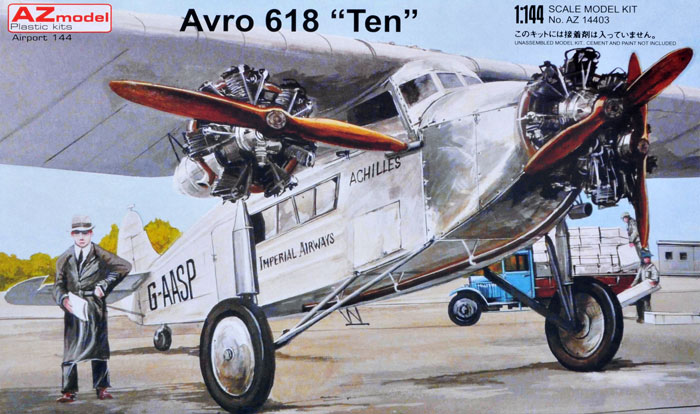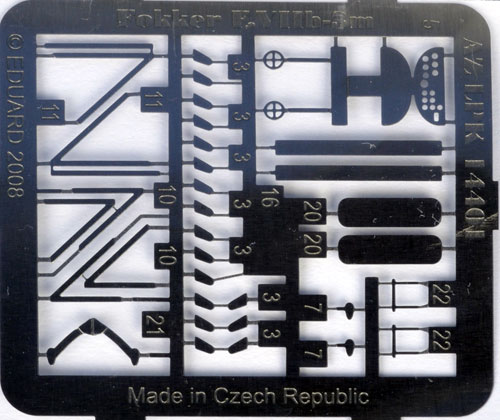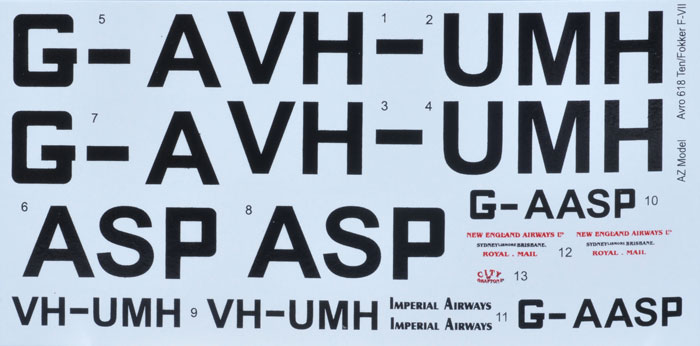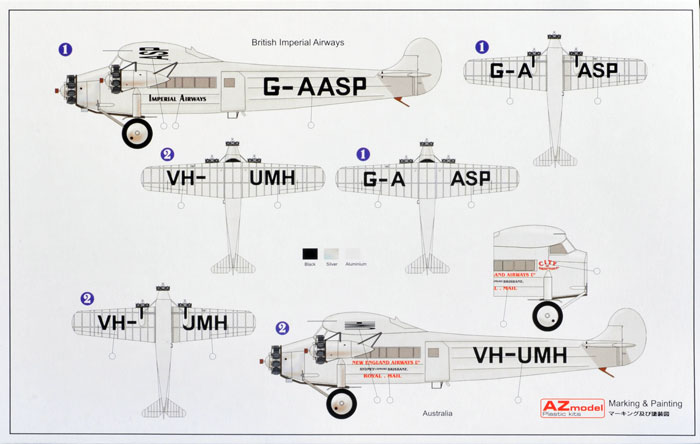Avro 618 Ten

AZ Model, 1/144 scale
S u m m a r y : |
Catalogue Number: |
AZ Model 14403 - Avro 618 Ten |
Scale: |
1/144 |
Contents & Media |
27 x light-tan styrene, 3 x cream resin, 1x photo-etch (PE) fret, 1 x flat photo-film for windscreen & windows and decals for two subjects |
Price: |
Available online from Hannants for £13.32 and Modelimex for €15.00 |
Review Type: |
First Look |
Advantages: |
A nice model of an important subject, with good detail levels for the scale. |
Disadvantages: |
The acetate film used for the all glazing may prove very hard to fit satisfactorily. Also some would prefer the kit to provide exhaust manifolds and pipes rather than having to scratch-build them. |
Conclusions: |
Not a “shake & bake” kit, but definitely the basis for a very nice model if you are prepared to work with some rather fiddly parts and scratch-build a few bits. |
Reviewed by Mark J. Davies

HyperScale is proudly supported by Squadron.com
The Fokker F VII started life as a single-engined aircraft, but gained another two when it entered the Ford Reliability Tour in 1925. The production versions of what became the F VIIa/3m, F VIIb/3m and F.10 were all known as Fokker Trimotors.
The F VIIb/3m was produced by several companies under licence, and Avro produced 14 as the Model 618 Ten. The “Ten” referred to number of people it could carry including two crew. The licence permitted Avro to sell the 618 within the British Empire with the exception of Canada (presumably Fokker I the USA had rights to this market).
AZ Model's 1/144 scale Avro 61 Ten consits of a quite cleanly moulded sprue of clearly limited run parts for the airframe, engine nacelles and major undercarriage struts. Two fuselages are provided, each in two halves. I could not tell the difference, even after removing them from the sprue and dry-fitting. But the instructions indicate there must be a difference as they direct the two parts to be used for this version.
Although I don’t feel it’s an issue, I should mention that quite large ejection stubs will need to be removed from the inner surfaces of the wings and fuselage. However these will leave no visible marks. The wing has fine engraved detail. Of course the real wing was skinned in plywood with fabric covering and had some reinforcing strips. In this scale it might be preferable to fill the lines and have a smooth-skinned model.
The sprue also has 2 and 3-blade propellers, the 2-blade type being applicable to this kit. Propellers tend to be over-scale in thickness in most 1/72 kits, so the problem is potentially worse in 1/144 scale. Whilst this kit’s props do suffer from this problem they are about as good as it is likely to get in this scale when injected styrene is used. Personally I would still give them a bit of scrape and sand down.
The three radial engines are cast in resin with very delicate pushrods. In fact they are almost too delicate, and one or two will need to be replaced with very fine stretched sprue as air bubbles have eradicated them. The engines themselves are scab-castings, meaning that the entire rear face of the engine is attached to a circular scab of resin. The engines’ size and delicacy will require quite a bit care when removing them.
A small PE fret provides an instrument panel and control wheels for the interior. It also has the engine nacelle mounting struts, main undercarriage braces and a pair of mudguards. These last items will benefit from annealing before being curved to fit. Then come 17 control horns, a tail skid and finally two teardrop shapes. These last items are shown as being fitted outboard on the wing’s upper surface near the leading edge. I don’t know what these are, but I’m sure they would benefit from having their cross section built up with either Mr Surfacer, white glue or similar.

The windscreen and side windows consist of a clear acetate film with the window frames printed on. These have the potential to look extremely good given their clarity and thin frame-lines, but I suspect that considerable care will be needed to cut and fit them. I’m not sure if positioning the windows as an exact fit in the fuselage slots is best, or whether it would make better sense to rebate behind the apertures making the plastic as thin as possible and then fix the film in from behind. An alternative to the kit windows would be to insert some clear styrene in the side window apertures, blend and polish it, then use decal strip for window frames.
The windscreen will need care folding and fitting. I can only think that white glue could be used to blend into the fuselage (if needed) as it will not be strong enough to support media that need sanding. To be honest I think clear resin offers abetter solution to glazing this type of small model. I accept though that more resin might push the price point up, and admit I have not tried to use this method – so I may be being alarmist!
The instructions indicate the need to scratch-build three collector rings and exhaust pipes from wire. The outboard engine’s pipes will be a bit fiddly because of their shape, but the centre engine’s long exhaust should be straightforward to make. Again I feel more resin could have helped here – probably with integral exhaust manifolds on the kit’s resin engines and simple resin or styrene pipes to be fixed to these later on.
The decals for New England Airways Ltd and British Imperial Airways look to be well registered with good colour density.

The aircraft history is in English. The instruction sheet has a parts map, and the assembly diagram is concise and quite adequate for the task. Interior colour call-outs are in English.
The resin and PE parts each have their own zip-lock bag and the all parts and decals are sealed in a larger zip-lock bag. The box has nice artwork on the front and coloured painting guide on the back with decal locations indicated. Colour call-outs are in English.

This kit has the potential to build into a charming and quite tiny model with high levels of scale refinement and detail for the scale. The challenges it offers with its windows and exhaust pipes will bring deep satisfaction to some modellers, and certainly do not represent insurmountable problems. However, I feel some people might wish for the manufacturer to have engineered better and less demanding solutions to these two areas of the kit.
Thanks to AZ Models for the review sample.
Review Text Copyright © 2008 by Mark Davies
Page Created 3 December, 2008
Last updated
3 December, 2008
Back to HyperScale Main Page
Back to Reviews Page |
Home
| What's New |
Features |
Gallery |
Reviews |
Reference |
Forum |
Search